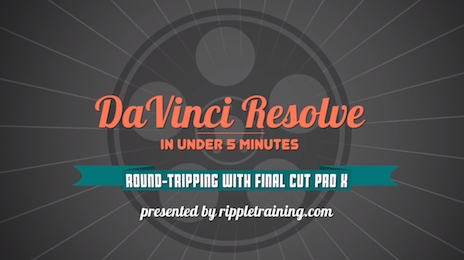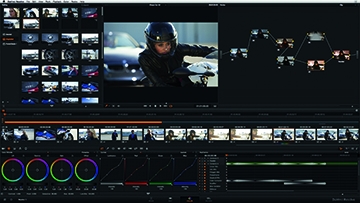
So the grand poobahs at ProVideoCoalition wanted all of us gurus to write a few year end lists. There are all kinds of things that are important to editors and video professionals that could be turned into lists: plug-ins, equipment, innovative productions.
My list is of none of these things. But hopefully, it will be even more helpful and valuable. Oftentimes I get called in to fix projects that have been started by other editors, so I see a lot of other people’s work. There are a few common mistakes that I see over and over again. So welcome to “My New Year’s Resolution List of Mistakes That You Should Avoid Next Year.” Some are technical. Some are creative. And some are business mistakes or client relationship mistakes. There are also a few positive “to dos” to add to your New Year’s Resolution list.
1) Overextended supers: Oftentimes when I’m working on another editor’s sequence, I spot this error. A name super of other graphic keyed over video extends one frame beyond the shot for which it was intended. Sometimes this is very difficult to spot. The most common reason for this error is command or control-dragging to find the end of a given segment. If you do this, the outpoint you mark is actually one frame PAST the end of the segment. There are a few ways to prevent this error. On an Avid, if you option-control drag, it actually marks the last frame of the segment instead of the first frame of the segment. You can also use the Mark Clip button and then change your Mark In. On Final Cut Pro, using Superimpose while parked on a segment will spare you from this error. But Final Cut Pro works the same was as Avid when it comes to locating and editing around a transition between two segments. Both systems have Mark In points that are INCLUSIVE of the frame on which you are parked. That means if you mark an in point, it is at the BEGINNING of the frame on which you are parked, but if you mark an out point, it is marked at the END of the frame on which you are parked. This is the most common reason for this error. So be cognizant of the exact frame that your keys are ending. If you have to, zoom in all the way to the end point of the transition to make sure that the two tracks are ending at the same frame.
2) Multiple levels of matching dissolves. If you have a stack of effects and you want to transition to or from another stack of effects or to fade the stack to black, you should NOT simply do dissolves on all layers of the transition. This looks terrible and can cause nasty looking transitions. You should create submasters or subsequences of the stacked effect first and then use a single transition effect to transition to the next part of the sequence. For those that have any experience with a video switcher, the analogy is cutting or dissolving from a mix effect bank to another mix effect bank. You’d never try to do this effect by using one fader to dissolve away the CG and another layer to dissolve away the background video while at the same time dissolving in another CG on top of the new background video, but that is essentially what you are doing when you put multiple levels of dissolves or other transition effects on multiple layers. On a switcher, you transition from one mix effect bank to another and in a non-linear editor, you collapse (an Avid term) the entire stack of effects down to a single layer and then transition from that single layer to another single layer. This includes taking a multi-layer effect to black. Although, on an Avid one trick that I think escapes many editors is that there is a special transition effect that can be placed on just the top-most layer of a stack to take ALL of the clips in the stack to black. That is the Fade to Color effect. There is also a Fade from Color effect that can be used when fading up to a stack of effects at the beginning of a sequence. The default color for this effect – thankfully – is black, but it can also be used to transition to any other color. If you think that the effect of multiple dissolves is really the same as using a single dissolve, the problem is that while the background video (v1) is fading to black, the layers above it are actually getting less opaque instead, so the effect is very messy. This is very evident if one of the layers is supposed to be covering something up. Consider if you were re-tagging a TV spot that had an old phone number on it. You place some kind of effect above the phone number to cover it up and add the new phone number on top of it. If you do a dissolve on all layers, as the video is fading to black, the old phone number will be visible as the effect that covers it dissolves away! This is simply poor craftsmanship. Make a New Year’s Resolution to avoid doing this.
3) This is a fairly “rookie” mistake, but I have seen it MANY times from editors that I thought should know better. I also have to admit that I’ve done it once or twice by mistake when I was rushed at the end of the project. The mistake is to cut in both (or maybe ALL) tracks of audio from a shoot tape. This may be less damaging if the mixer only used a single mic and simply mixed the left channel a little lower than the right, but generally the two audio tracks are from two different mics, like a book and a lav. Or in the WORST case scenario, the two mics are the camera mic and a lav. Having both of these tracks cut into your timeline means that the beautiful audio that the location mixer recorded now sounds horrible or creates a bizarre stereo mix with different sounding audio coming from each speaker. As early as possible – hopefully before you even cut the audio into the sequence – you should select the best possible microphone and only cut that microphone into the sequence. The sole exception that I’ve found to this is that sometimes one mic sounds better at the beginning but later has an issue, like it begins to break up due to a bad cable or a dying battery. Then you are forced to switch from one mic to another in mid-program. In that case, unless you can mask the change in audio in some way, you need to go with the mic that has no problems, which can sometimes mean re-cutting the audio from that channel. Because of this, I sometimes wait to pick the best mic track until I’ve cut together the rough cut. Then I know that my favorite mic is available throughout the entire production. However, that has bit my occasionally if I’m working very fast and don’t have time to choose and delete the other channel.
4) While we’re discussing audio, another New Year’s Resolution is to have a little discipline when laying down audio AND video tracks in a sequence. Try to keep all of your voice overs on one track and all of your sound effects on specific tracks and all of your music on specific tracks. This will make it easier to do specialized audio layoffs, like M&E layoffs, without narration or dialog. (M&E mixes are commonly used to create international versions of productions that can be re-recorded with native languages. Many editing applications, like the Avid, have the ability to actually LABEL your audio tracks instead of just numbering them. This is a GREAT idea to help you establish and maintain discipline about track use because it’s easier to remember to put your narration on the “voice over track” than “A1.” This also makes it significantly easier for another editor or a sound mixer to step in and edit and mix stuff, even if you THINK you’re going to be the only editor that ever touches the project. ALSO, it is great for projects that get archived and then, two years later you have to edit again, because if you have track discipline and label your tracks, then if you bring that project back later, it’s easier to see how the project is laid out and if you’re missing any media, you can easily see what part you’re missing, like maybe all of the audio on the “voice over” track is missing. If it’s scattered throughout the project, you might not know that it’s all from the same file. But if it’s all on the same track, then trouble shooting your sequence becomes MUCH easier.
5 and 6) “Save early and save often” and know where all your files are saved. Nothing is worse than losing a valuable project. You may want to consider purchasing one of those utility programs that keeps track of off-line media. For example if you have thousands of DVDs and CDs laying around with data on them, plus a dozen or so Firewire and USB drives and maybe even some stacks of off-line SCSI drives, there are programs like DiskCatalogMaker (http://diskcatalogmaker.com/) that keep an on-line catalog of what is stored on all those disks and drives. DiskCatalogMaker, and others like it, allow you to search for files on drives that are not even mounted. – You can be the fastest editor in the world, but if it takes you two days to find the files for that project a client wants to revise, your speed in delivering the project is significantly reduced.
7) Always know who the real decision maker is on a project. Who are you really trying to please? Often times a producer who is your direct contact may be trying to second-guess the desires of their client. Or it may not be instantly apparent by the interpersonal relationship of a team of clients in the room who is the REAL decision-maker. Don’t leave this to guesswork. Know whom you’re really trying to please.
8) Always learn new things. Every day, visits to sites like www.provideocoalition.com, books, classes and DVDs should be used to keep you up-to-date, inspired and excited about trying new things. Many times, even learning rudimentary things has inspired me to use a feature or function in a new way that adds creative flair to a project. With the speed that the industry is moving, it’s very easy to get left behind. You could even consider bartering your knowledge of one application with another editor’s knowledge of a different application. I’ve traded color correction training for Final Cut training. In a similar vein, continue to expand your horizons and learning OUTSIDE of your career path. It’s amazing how much stuff from outside you can apply to what you’re doing. I call it cross-pollenization. You take ideas from other industries or other arts and let them inform YOUR industry and art. Sometimes those are the most innovative and interesting ideas.
9) In these uncertain economic times, expand your network every single day. Devote time to it. Make contact with new potential clients, new freelancers, other editors, equipment vendors, et cetera. And keep this list organized and easy to access. Use all the great computer tools for saving and cataloging your contacts. Then you need to make sure to contact those people frequently, especially the potential clients. I am confident of my skills, but I know that people who have not worked with me don’t know how much I can bring to the table, so I have to be persistent with those people. I just landed a new client and when I finally met the woman who booked the job she said “So you’re Steve Hullfish. You have to be the most persistent editor I’ve ever met.” I called her over and over again. She never told me to leave her alone or that she wasn’t interested, so I just kept calling until she finally took my phone call. I called once or twice a week and left short, simple messages. I didn’t want to be a pest, but I also knew that I could do good things for them. Until I get a flat “no” I will keep trying. It paid off for me AND for the client. I got the work and they were happy to finally work with a new, capable person that expanded their capabilities.
10) Hey, it’s the holidays and times are tough for everyone this year, so my final New Year’s Resolution is to volunteer your talents to a cause. I don’t care what the cause is. For me, it’s a local church. For you, maybe it’s rescuing the whales or helping the homeless. Either way, find out how the talent you have been given can help someone else. There are a number of completely selfish reasons to do this: It allows you to further grow your network of people who have worked with you or who have seen your work. Those contacts could well provide you with your next paying job. Volunteering also allows you the flexibility and opportunity to try new things. Perhaps you wouldn’t try doing something with a paying client, but with some pro bono work you can break out and experiment, either technically or creatively.

Filmtools
Filmmakers go-to destination for pre-production, production & post production equipment!
Shop Now












